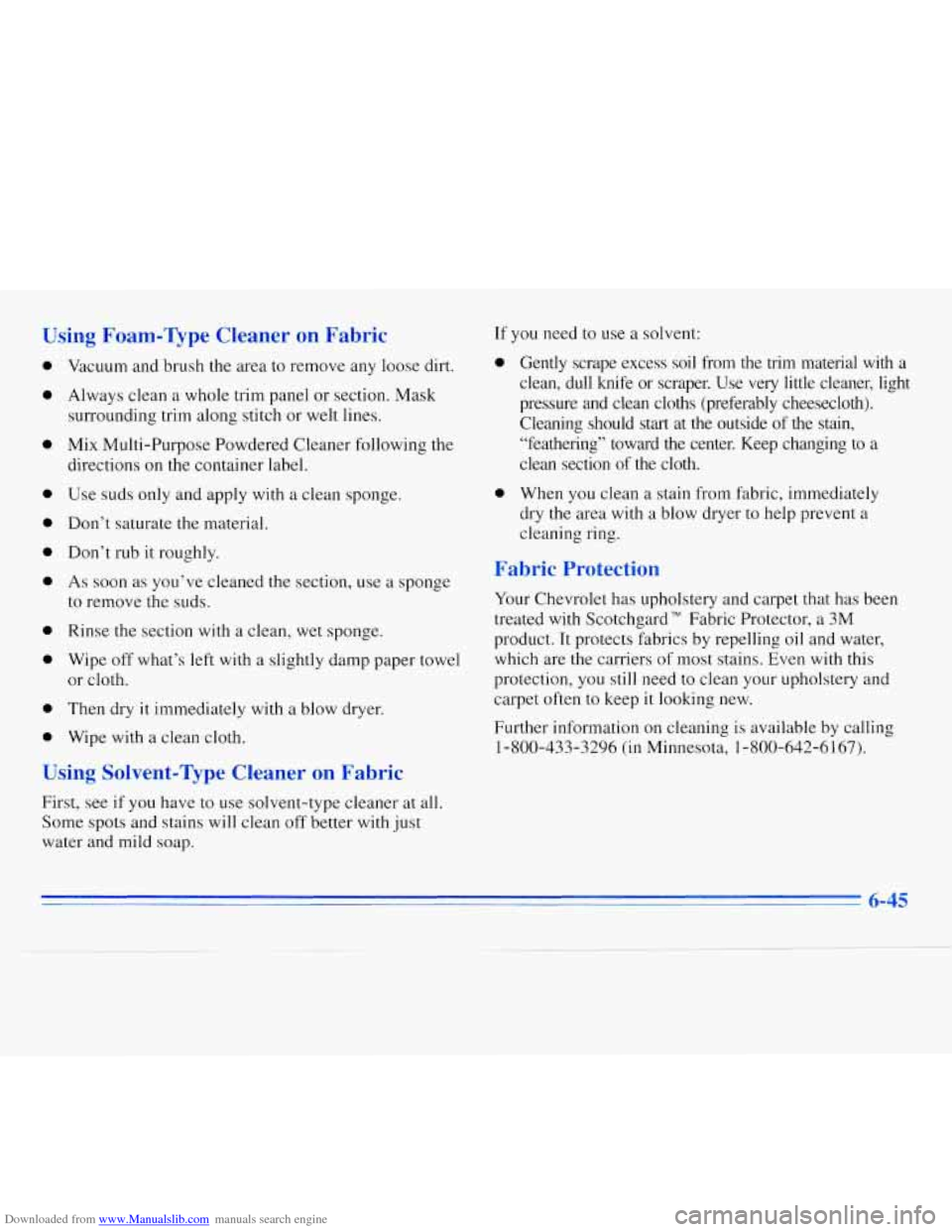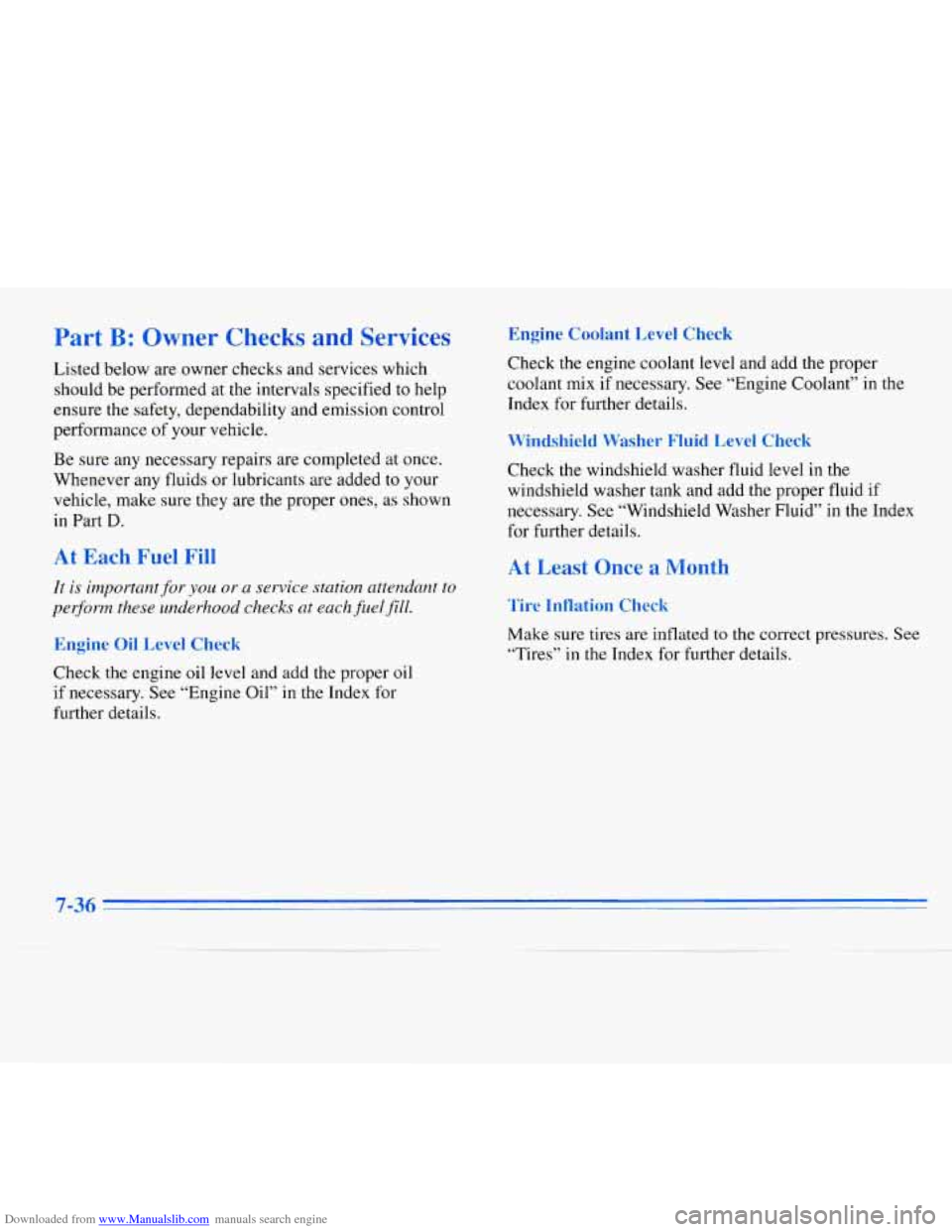1996 CHEVROLET MONTE CARLO oil pressure
[x] Cancel search: oil pressurePage 10 of 340

Downloaded from www.Manualslib.com manuals search engine "-
Ihese are some of the symbols you may find on your vehicle.
hide Symbols
For example,
these symbols
are used
on an
original battery:
POSSIBLE A
CAUTION
INJURY
PROTECT EYES BY
SHIELDING
CAUSTIC
I
BURNS
I
AVOID
SPARKS
OR
FLAMES
SPARK
OR ,111,
1 FLAME
COULD
EXPLODE BATTERY
These symbols
are important for you and
your passengers
whenever your
vehicle
is
driven:
DOOR LOCK
UNLOCK
FASTEN SEAT
BELTS
POWER
WINDOW
These symbols have
to do with
your lights:
SIGNALS e
TURN
RUNNING
* 0
DAYTIME . . .
LAMPS
FOG LAMPS
$0
These symbols
are
on some of
your controls:
WINDSHIELD
WIPER
WINDSHIELD DEFROSTER
WINDOW
DEFOGGER
VENTILATING FAN
These symbols
are used
on
warning and
indicator lights:
COOLANT -
TEMP -
CHARGING I-]
BATTERY
SYSTEM
BRAKE
(a)
COOLANT a
ENGINE OIL w,
PRESSURE
ANTI-LOCK
(a)
BRAKES
1
Here arc some
other symbols
you
may see:
FUSE
P
LIGHTER
HORN
)tr
SPEAKER
b
FUEL 1
ii
Page 109 of 340

Downloaded from www.Manualslib.com manuals search engine 0 If you make a hard stop, the light may come on for a
moment. This is normal.
Low Oil Level Light
Don’t keep driving if the oil pressure is low. If
you do, your engine can become
so hot that it
catches fire. You or others could be burned.
Check your oil as soon as possible and have your
vehicle serviced.
I NOTICE:
Damage to your engine from neglected oil
problems can be costly and
is not covered by your
warranty.
LOW
OIL
Your engine is equipped
with an oil level monitoring
system. When the ignition
key
is turned on, the LOW
OIL light will briefly flash.
If the light does not flash,
have
it fixed so it will be
ready to warn you if there’s
a problem.
If the light stays on, stop the vehicle on a level surface
and turn
the engine off. Check the oil level using the
engine oil dipstick. (See “Engine Oil”
in the Index.)
If the light does not flash, have the low oil level sensor
system repaired
so it will be ready to warn you if there’s
a problem.
The oil level monitoring system only checks oil level
during the brief period between key
on and engine
crank. It does not monitor engine oil level when the
engine is running. Additionally, an oil level check
is
only performed if the engine has been turned off for a
considerable period of time, allowing the oil normally in
circulation to drain back into the oil pan.
Page 156 of 340

Downloaded from www.Manualslib.com manuals search engine Here are some things you can check before a trip:
Windshield Washer Fluid: Is the reservoir full? Are
all windows clean inside and outside?
0 Wiper Blades: Are they in good shape?
0 Fuel, Engine Oil, Other Fluids: Have you checked
all levels?
Lamps: Are they all working? Are the lenses clean?
0 Tires: They are vitally important to a safe,
trouble-free trip. Is the tread good enough for
long-distance driving?
Are the tires all inflated to the
recommended pressure?
along your route? Should you delay your trip a
short
time to avoid a major storm system?
Maps: Do you have up-to-date maps?
0 Weather Forecasts: What’s the weather outlook
Highway Hypnosis
Is there actually such a condition as “highway hypnosis”?
Or is
it just plain falling asleep at the wheel? Call it
highway hypnosis, lack
of awareness, or whatever.
There is something about an easy stretch of road with
the
same scenery, along with the hum of the tires on the
road, the drone of the engine, and the rush of the wind
against the vehicle that can make you sleepy. Don’t let it
happen to you! If it does, your vehicle can leave the
road in
less than a second, and you could crash and
be injured.
What can you do about highway hypnosis? First, be
aware that it can happen.
Then here
are some tips:
0 Make sure your vehicle is well ventilated, with a
comfortably cool interior.
0 Keep your eyes moving. Scan the road ahead and to
the sides. Check your rearview mirrors and your
instruments frequently.
0 If you get sleepy, pull off the road into a rest, service
or parking area and take a nap, get some exercise, or
both. For safety, treat drowsiness on the highway as
an emergency.
Page 253 of 340

Downloaded from www.Manualslib.com manuals search engine Using Foam-Type Cleaner on Fabric
0
0
0
0
0
0
0
0
0
0
e
Vacuum and brush the area to remove any loose dirt.
Always clean a whole trim panel or section. Mask
surrounding trim along stitch or welt lines.
Mix Multi-Purpose Powdered Cleaner following the
directions on the container label.
Use suds only and apply with a clean sponge.
Don’t saturate
the material.
Don’t rub
it roughly.
As soon as you’ve cleaned the section, use a sponge
to remove the suds.
Rinse the section with a clean, wet sponge.
Wipe off what’s left with
a slightly damp paper towel
or cloth.
Then dry
it immediately with a blow dryer.
Wipe with a clean cloth.
Using Solvent-wpe Cleaner on Fabric
First, see if you have to use solvent-type cleaner at all.
Some spots and stains will clean off better with just
water and mild soap. If you
need to use a solvent:
0 Gently scrape excess soil from the trim material with a
clean, dull knife or scraper. Use very little cleaner, light
pressure and clean cloths (preferably cheesecloth).
Cleaning should
start at the outside of the stain,
“feathering” toward the center. Keep changing to a
clean section
of the cloth.
0 When you clean a stain from fabric, immediately
dry the area with a blow dryer to help prevent a
cleaning ring.
Fabric Protection
Your Chevrolet has upholstery and carpet that has been
treated with Scotchgard” Fabric Protector,
a 3M
product. It protects fabrics by repelling oil and water,
which are the carriers of most stains. Even with this
protection, you still need to clean your upholstery and
carpet often to keep it looking new.
Further information on cleaning
is available by calling
1-800-433-3296 (in Minnesota, 1-800-642-6
167).
6-45
Page 264 of 340

Downloaded from www.Manualslib.com manuals search engine Underhood Electrical Center -- Passenger’s Side
Some fuses are in a fuse block on the passenger’s side of
the engine compartment.
...D , :::
/- .-
uuu A.I.R. PMP RlCMPT REL ECM BAT
on0 A/C CONT TCC
F/INJN ECM IGN ELEK IGN
A/C CONT
TCC
Description
A.I.R. Relay
Fuse
A.I.R. PMP
3.4L
R/CMPT REL Remote Trunk Release
ECM
BAT Powertrain Control Module (PCM), Fuel Pump/Oil Pressure
Switch,
Fuel Pump Relay,
Fan Cont
#I Relay
A/C CMPR Relay
(VIN M Only)
Automatic Transaxle, Transaxle
Range Switch
(VIN M only)
6-56
Page 306 of 340

Downloaded from www.Manualslib.com manuals search engine Long Trip/Hi-bvay Maintenance Schedule
97,500 Miles (16- 500 km)
0 Change engine oil and filter (or every
12 months, whichever occurs first).
An Emission Control Service.
17 Lubricate steering ball joints (or every
6 months, whichever occurs first).
17 Rotate tires. See “Tire Inspection and
Rotation”
in the Index for proper rotation
pattern and additional information. During
tire rotation, check brake calipers for
freedom of movement. Refer to the
appropriate
GM service manual for proper
caliper service procedures.
DATE ACTUAL MILEAGE SERVICED BY
100,000 Miles (166 000 km)
0 Drain, flush and refill cooling system (or
every
60 months since last service,
whichever occurs first). See “Engine
Coolant”
in the Index for what to use.
Inspect hoses. Clean radiator, condenser,
pressure cap and neck. Pressure test the
cooling system and pressure cap.
An Emission Con‘trol Service.
0 Inspect spark plug wires.
An Emission Control Service.
7-34
Page 308 of 340

Downloaded from www.Manualslib.com manuals search engine Part B: Owner Checks and Services
Listed below are owner checks and services which
should be performed at the intervals specified to help
ensure the safety, dependability and emission control
performance of your vehicle.
Be sure any necessary repairs are completed at once.
Whenever any fluids or lubricants are added to your
vehicle, make sure they are the proper ones, as shown
in Part
D.
At Each Fuel Fill
It is important for you or a service station attendant to
per$orm these underhood checks at each fuel
fill.
Engine Oil Level Check
Check the engine oil level and add the proper oil
if necessary. See “Engine Oil” in the Index for
further details.
Engine Coolant Level Check
Check the engine coolant level and add the proper
coolant mix if necessary. See “Engine Coolant” in the
Index for further details.
Windshield Washer Fluid Level Check
Check the windshield washer fluid level in the
windshield washer tank and add the proper fluid if
necessary. See “Windshield Washer Fluid” in
the Index
for further details.
At Least Once a Month
.Tire Inflation Check
Make sure tires are inflated to the correct pressures. See
“Tires” in the Index for further details.
7-36